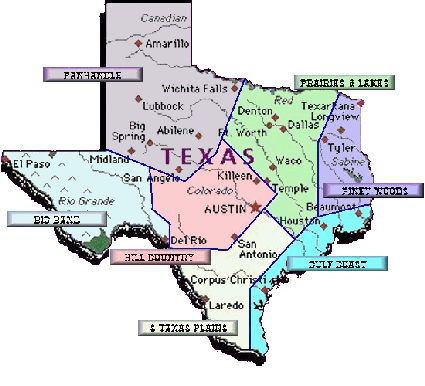Texas Geographical Regions
Texas is geographically devided into seven main areas. Click on one of the tabs for more information on The Panhandle, The Gulf Coast or any of the other five areas.
Panhandle
PANHANDLE PLAINS - The distinctive shape of the Panhandle holds many of Texas' panoramic treasures. Llano Estacado is the southern tip of the Great Plains, and the Prairie Dog Fork of the Red River shapes Palo Duro Canyon.
Mastodons and great bisons were hunted by Native Americans before written records were kept and the Pueblos turned the rocky grassland into farmland.
In the final confrontation between the Texas Rangers and the Comanche, Quanah Parker and his families were forced to walk to Oklahoma Territory.
The year before, in 1876, Charles Goodnight established one of the region's first ranches.
Prairies and Lakes
PRAIRIES & LAKES - "Where the West Begins" so describes the city of Fort Worth, famous for its stockyards, railheads and the largest honky-tonk anywhere, Billy Bob's.
Dallas, to the east of Fort Worth, has made itself a prominent center of banking, merchandising and international shipping.
Attractions include Six Flags Over Texas, Southfork Ranch (where the TV series "Dallas" was made), the State Fair of Texas and the Mesquite Championship Rodeo.
North Central Texas is becoming the Third Coast Movie Capital of the States.
Piney Woods
PINEY WOODS - The state of Texas' first oil well was claimed at Nacogdoches.
Kilgore and Longview swelled with a population increase when the East Texas Oil Field was discovered, and the lumber business boomed.
The Piney Woods in East Texas boasts of pine trees reaching the heavens, dogwood trees blossoming white and pink, and Caddo and Alabama-Coushatta tribes still weaving their magic.
A grand feature of the Piney Woods is the Big Thicket National Preserve.
Big Bend
BIG BEND - Where the Rio Grande makes a big bend in the state. Where the Davis and Chisos Mountains sit majestically. Where the mystery of the Old West still filters through the air.
The "Washita Wolf", Clay Allison, is buried in Pecos.
In Langtry sits Judge Roy Bean's courthouse.
Fort Davis and Fort Stockton sit as reminders of the soldiers who fought for the early settler and to maintain law and order.
The three largest cities - El Paso, Midland and Odessa - are centers of commerce and produce oil and oil products.
Big Bend National Park, all 800,000 acres, attracts more than 300,000 visitors a year.
Hill Country
HILL COUNTRY - Bluebonnets blooming delicately in the spring, underground springs bubbling clear water, bedrock caverns carved out through the years and limestone cliffs jutting into an endless blue sky - these are just some of the natural beauties of the Texas Hill Country.
The state capital, Austin, (formerly known as Waterloo), sits in the heart of the Hill Country. Named for Stephen F. Austin, the city is expanding as the Live Music Capital of the World.
The city, based on higher education with the University of Texas, is fast becoming a source of commerce.
Gulf Coast
GULF COAST - A virtual outdoor paradise! The coast holds warm waters, a temperate climate and thousands of water creatures including all those "Winter Texans."
Cabeza de Vaca and his men shipwrecked on the coast in 1528, Spindletop blew in 1901 and the King Ranch in Kingsville are some of the Gulf Coast's historical notes.
Houston, Corpus Christi, Beaumont and Port Arthur offer a taste of the Gulf.
South Texas Plains
SOUTH TEXAS PLAINS - The Plains tell of a history far richer than many other places in Texas.
In what is now downtown San Antonio, (formerly known as Bexar), the Alamo, the Cradle of Texas Liberty sits and reminds Texans of a time when more than 180 men died for a cause they believed in.
Further south is Laredo, the only city in Texas that has officially flown seven flags. To its south is its sister city of Nuevo Laredo, Mexico.
The Old West influence is shown by the ranches here; conjunto, mariachis and Tejano music fill the air; and the spicy food of Old Mexico permeate one's senses.
